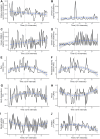Case Report: Endocrine, immune and disease dynamics in a patient with rheumatoid arthritis during flare and medication change
- PMID: 40406145
- PMCID: PMC12094934
- DOI: 10.3389/fimmu.2025.1491475
Case Report: Endocrine, immune and disease dynamics in a patient with rheumatoid arthritis during flare and medication change
Abstract
Objective: Rheumatoid arthritis (RA) is a chronic autoimmune disease of mostly unknown etiology and pathophysiology. In this integrative single-case study on a patient with RA, we had the unique opportunity to closely monitor the individual dynamics of endocrine, immune and disease variables during a naturally occurring flare-up and subsequent medication change.
Methods: The 59-year-old female RA patient collected her entire urine over 30 days in 12-h intervals (60 consecutive measurements in total). Subsequently, cortisol, interleukin-6 (IL-6), orosomucoid-2 (ORM-2), neopterin and creatinine levels were determined in the urine samples. Further, each morning and evening, the patient completed the DIARI, a set of questionnaires on variables such as perceived pain, perceived RA disease activity and emotional states. Once a week, the patient was interviewed online and had an appointment with her rheumatologist, in which several indices of RA disease activity were determined: SDAI, CDAI and DAS28. From these data various time series were constructed for statistical analysis.
Results: RA disease state increased from low to high activity during the first 12 study days. Thereupon, the medication was changed, which proved effective in reducing RA disease activity. However, the levels of urinary neopterin, urinary IL-6 and urinary ORM-2 did not show any response, neither to the increasing disease activity nor the medication change. The patient's daily reports on pain, RA disease activity, emotional states and body temperature, however, mirrored the course of the rheumatologic indices.
Conclusion: This integrative single-case study clearly demonstrated the importance of process analysis for the evaluation of therapeutic measures in RA. In the studied patient, urinary levels of neopterin, IL-6 and ORM-2 were not found to be appropriate biomarkers of short-term fluctuations in RA disease activity. Instead, the results reported by the patient proved to be a useful tool for ambulatory and longitudinal monitoring of RA.
Keywords: cortisol; flare; integrative single-case study; interleukin-6; neopterin; orosomucoid-2; rheumatoid arthritis; time series.
Copyright © 2025 Seizer, Gostner, Garbers, Licht, Sager, Brandl and Schubert.
Conflict of interest statement
The authors declare that the research was conducted in the absence of any commercial or financial relationships that could be construed as a potential conflict of interest.
Figures


Similar articles
-
Evaluation of self-report questionnaires for assessing rheumatoid arthritis activity: a cross-sectional study of RAPID3 and RADAI5 and flare detection in 200 patients.Joint Bone Spine. 2012 Jan;79(1):57-62. doi: 10.1016/j.jbspin.2011.03.014. Epub 2011 May 6. Joint Bone Spine. 2012. PMID: 21550283
-
Patient-reported outcomes as early warning signs of flare following drug cessation in rheumatoid arthritis.RMD Open. 2025 Apr 1;11(2):e005442. doi: 10.1136/rmdopen-2025-005442. RMD Open. 2025. PMID: 40169281 Free PMC article.
-
The comparative responsiveness of the patient self-report questionnaires and composite disease indices for assessing rheumatoid arthritis activity in routine care.Clin Exp Rheumatol. 2012 Nov-Dec;30(6):912-21. Epub 2012 Dec 17. Clin Exp Rheumatol. 2012. PMID: 22935335
-
Assessment of disease activity and treatment outcomes in rheumatoid arthritis.J Manag Care Pharm. 2011 Nov-Dec;17(9 Suppl B):S09-13. doi: 10.18553/jmcp.2011.17.s9-b.s09. J Manag Care Pharm. 2011. PMID: 22073934 Free PMC article. Review.
-
Morning symptoms in rheumatoid arthritis: a defining characteristic and marker of active disease.Scand J Rheumatol Suppl. 2011;125:1-5. doi: 10.3109/03009742.2011.566433. Scand J Rheumatol Suppl. 2011. PMID: 21529303 Review.
References
-
- Smolen JS, Landewé RBM, Bijlsma JWJ, Burmester GR, Dougados M, Kerschbaumer A, et al. . EULAR recommendations for the management of rheumatoid arthritis with synthetic and biological disease-modifying antirheumatic drugs: 2019 update. Ann Rheumatol Dis. (2020) 79:685–99. doi: 10.1136/annrheumdis-2019-216655 - DOI - PubMed
-
- Schubert C, Lampe A, Rumpold G, Fuchs D, König P, Chamson E, et al. . Daily psychosocial stressors interfere with the dynamics of urine neopterin in a patient with systemic lupus erythematosus: an integrative single-case study. Psychosom Med. (1999) 61:876–82. doi: 10.1097/00006842-199911000-00024 - DOI - PubMed
Publication types
MeSH terms
Substances
LinkOut - more resources
Full Text Sources
Medical
Miscellaneous

